HackMaster Review
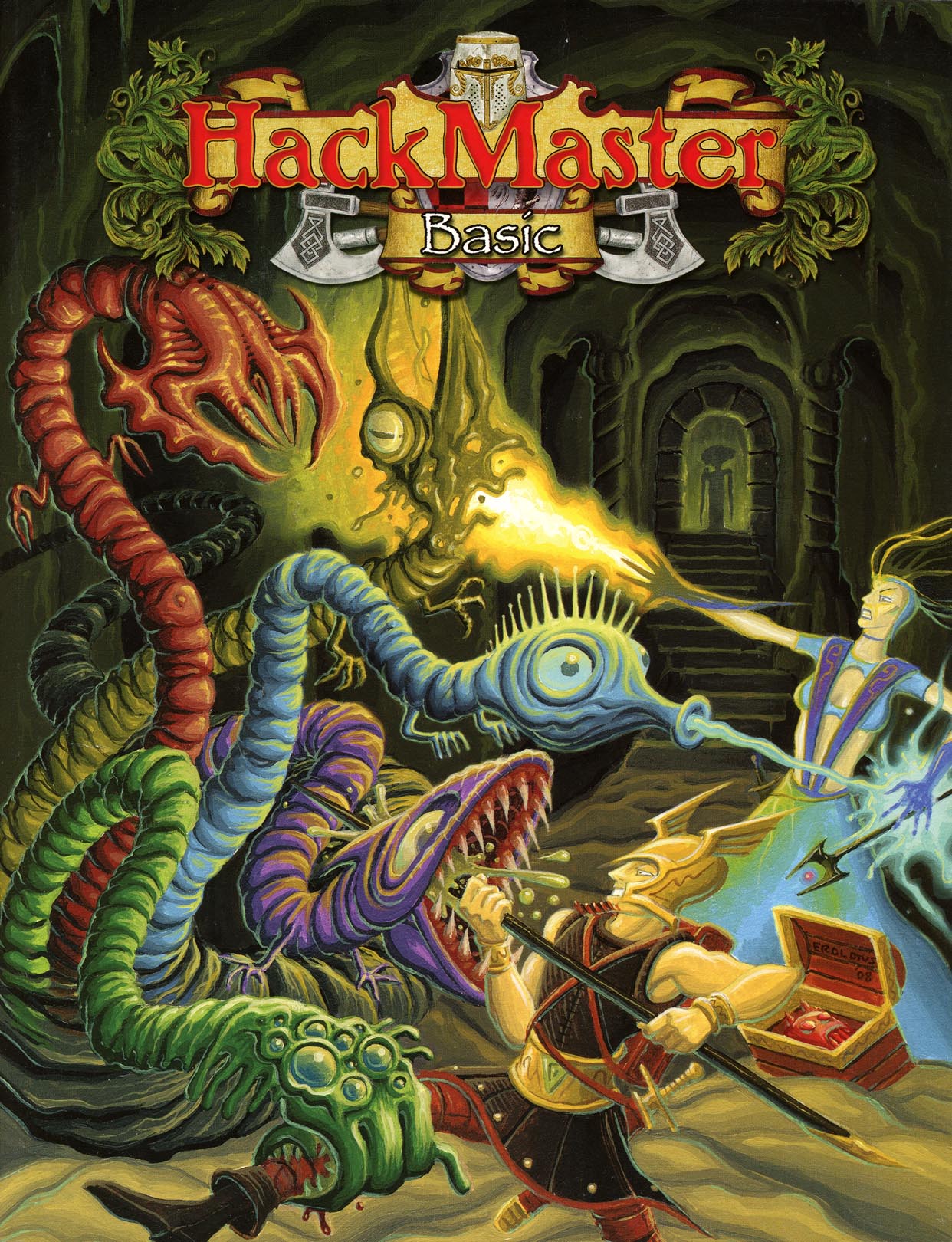 HackMaster 5e is the greatest game ever developed by humankind. It says so in the introduction of the Player’s Handbook, and they are goddamn right. Ironically, the game started out as a joke: it was a parody of Advanced Dungeons & Dragons from the pages of the Knights of the Dinner Table comic strip. KoDT started its run in Shadis and is nowadays published by Kenzer & Company, but it also appeared in Dragon. When Wizards of the Coast released their Dragon Magazine Archive, they reprinted the strips without anyone’s permission.
HackMaster 5e is the greatest game ever developed by humankind. It says so in the introduction of the Player’s Handbook, and they are goddamn right. Ironically, the game started out as a joke: it was a parody of Advanced Dungeons & Dragons from the pages of the Knights of the Dinner Table comic strip. KoDT started its run in Shadis and is nowadays published by Kenzer & Company, but it also appeared in Dragon. When Wizards of the Coast released their Dragon Magazine Archive, they reprinted the strips without anyone’s permission.
Enter David Kenzer, one of the ballsiest lawyers in the industry1, who immediately kicked down their door and held WotC in a chokehold until they came to an agreement: WotC won’t get further wedgies, while Kenzer & Co. can release Kingdoms of Kalamar as an official setting for D&D3e and their own AD&D derivative. There was a caveat, though: to make sure it didn’t step on the toes of the fledgling D&D3e, the game had to be parodistic in tone. Thus, HackMaster was released years before the OSR movement or even Castles & Crusades was a thing. It isn’t only a pioneer among retroclones, but also the only game whose first edition was its fourth.2
HackMaster 4e was AD&D on steroids with its over-the-top writing and snarky humor. The game had an amazing run, with a deluge of supplements and adventures, many of which were revamped versions of beloved classics. It also won the Origin Award for Game of the Year 2001. Of course, all good things must come to an end, including the license that made the game possible. Kenzer & Co. didn’t fret though, because they had another card up their sleeve. Instead of relying on the OGL, they built a brand new edition from scratch, which is more-or-less serious in tone, uses Kingdoms of Kalamar as its default setting, and uses their Aces & Eights western RPG’s engine.
Core Books
HackMaster Basic (2009) was fifth edition’s first book. It’s a 192-page softcover with an awesome Erol Otus cover and black & white interior. HMB covers levels 1 to 5. Player options are limited to four races (dwarf, elf, halfling, human) and four classes (cleric, fighter, mage, thief), though a decent number of quirks, flaws, skills/talents/proficiencies (STPs in short) add a good deal of variety and flexibility. All the important beats of the core system are there already. The original HMB was eventually replaced by a free version, which has pregens instead of character creation rules, and the dirt-cheap HMB+, which has character creation rules and goes up to level 10.
HackMaster Basic was only meant to be a gateway drug, though. It was soon followed by a line of “Advanced” books that are the most cherished pieces of my collection. They are all 368-400 pages long hardcover monstrosities with leatherette covers and full-color interiors.
Hacklopedia of Beasts (2011) was the first of them and immediately set the bar somewhere in the stratosphere for other monster books. Each monster entry takes two to eight pages to describe the creature, starting with a first-hand account and an illustration resembling natural history drawings, before moving on to ecology, habitat, and tactics. Combat stats are neatly summed up in the compact combat rose, while two other boxes below it show general information and monster yield3. These are often supplemented by a map showing the creature’s typical range on Tellene4, a picture of their tracks, and a silhouette for size comparison, which reminds me of my childhood dinosaur books. The thorough monster descriptions do get dry here and there, explaining trivialities in great detail, but then again, we still have people who have totally wrong ideas about how wolves behave or how utterly terrifying bears are5.
Player’s Handbook (2012) followed soon. It contains all the rules and content for players up to level 20. The number of playable races increased to 11 (with the addition of gnome, gnome titan6, grel7, half-hobgoblin8, half-orc, pixie-fairy9), the number of classes to 13 (with the addition of knight10, paladin11, barbarian, rogue12, assassin, fighter/mage, fighter/thief, thief/mage), and a shitton more quirks, flaws, STPs, spells, items, and so on. The rules were also fleshed out and expanded, with lots of advanced options, if the core wasn’t crunchy enough already. It’s a dense book, but fortunately, even with the more serious tone, there is still some of the old attitude, irony, and sarcasm in it that makes it immensely more readable and enjoyable than most RPG books out there.
GameMaster’s Guide (2015) was the last of the core books. They crammed a metric shitton of content into the book: rules for all manner of edge cases in combat, the iconic d10,000 critical tables, funky magical mishaps, sound design advice, charts for generating NPCs, mundane and magical treasure galore, and rules for common adventuring activities like training, torture, getting shitfaced, taking oaths, staying awake during watch, et cetera.
There were also supplements and adventures released over the years, but I want to focus on the core game here. So without further ado, let’s dive into what makes HackMaster tick. Buckle up, this will be a long and bumpy ride.
Characters
A HackMaster character is are multi-faceted gem—or overly complicated mess, depending on your taste. Character creation can take more than an hour if you aren’t prepared. When I was in my prime, I could create one in 20-30 minutes. Practice makes perfect.
HackMaster uses a hybrid system for character generation where you can both roll up some features and use Build Points to customize them. The more randomness you allow, the more BPs you get as compensation. You can spend BPs on improving ability scores, buying STPs, and rerolling some random rolls.
The seven ability scores are mostly familiar from D&D: Strength, Intelligence, Wisdom, Dexterity, Constitution, Looks, Charisma. They do work slightly differently from what people expect after years of D&D. For example, STR only affects damage in melee; attack modifiers for all weapons are based on DEX and INT. Initiative is also based on DEX and INT, while Defense is based on DEX and WIS—so it’s entirely possible to have a stupid, lumbering hulk who rarely hits, but hits really hard when they do. Every ability score influences something important. There are no dump stats in HackMaster.
Ability scores are generated using 3d6. You can choose between rolling them in order, rolling them in order and swapping too, or putting them wherever you want, but the less random the method, the less starting BP you gain. Each score also has a percentage value showing where the character is in its development towards the next integer. Unlike modern D&D, HackMaster not only abhors universal modifiers, it’s sometimes so granular, that certain stats grant bonuses even at 51%.
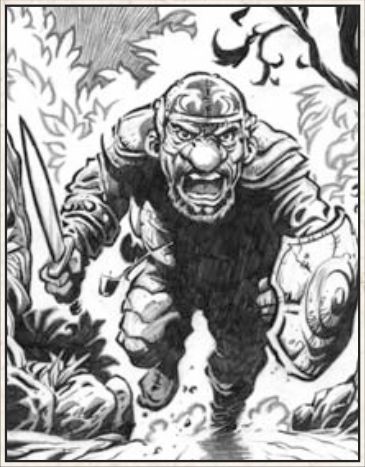 Races are far from cosmetic in HackMaster: some bonuses and penalties significantly alter how you play your character. For example, among other abilities, dwarves get a whopping +4 CON bonus, count as large creatures for knockback, but have inferior reach, which is a big fucking deal in combat as you will see later. Meanwhile, the slenderness of elves grants them +2 to Defense but counts as small creatures when determining HP and knockback. And let’s not mention pixie fairies, who require a completely unique playstyle. They have a very short lifespan, can fly, they are hard to hit, their weapons are useless, they can’t wear armour, and have such a shitty HP that they will likely die from a single blow. They do reincarnate at their mother tree after a while with a death penalty, though, so you can choose between playing carefully, or “live fast, die young, repeat”. No race has darkvision. The best you can get is the low-light vision of dwarves, gnomes, gnome titans, half-hobgoblins, and half-orcs. There are also racial reaction charts, which is especially punishing for humanoids13. While there are no racial level limits in HackMaster, a few classes are restricted for certain races, and your race defines how many BPs you have to spend on picking your class. Dwarf mages are awesome on paper, but will empty your BP budget before you can spend it!
Races are far from cosmetic in HackMaster: some bonuses and penalties significantly alter how you play your character. For example, among other abilities, dwarves get a whopping +4 CON bonus, count as large creatures for knockback, but have inferior reach, which is a big fucking deal in combat as you will see later. Meanwhile, the slenderness of elves grants them +2 to Defense but counts as small creatures when determining HP and knockback. And let’s not mention pixie fairies, who require a completely unique playstyle. They have a very short lifespan, can fly, they are hard to hit, their weapons are useless, they can’t wear armour, and have such a shitty HP that they will likely die from a single blow. They do reincarnate at their mother tree after a while with a death penalty, though, so you can choose between playing carefully, or “live fast, die young, repeat”. No race has darkvision. The best you can get is the low-light vision of dwarves, gnomes, gnome titans, half-hobgoblins, and half-orcs. There are also racial reaction charts, which is especially punishing for humanoids13. While there are no racial level limits in HackMaster, a few classes are restricted for certain races, and your race defines how many BPs you have to spend on picking your class. Dwarf mages are awesome on paper, but will empty your BP budget before you can spend it!
Classes define a character’s hit dice, combat stat bonuses, special abilities, starting proficiencies, and weapon specialization costs. They pretty much follow what you expect from them: fighters get better attack bonuses and buy weapon proficiencies and specialization dirt cheap; thieves get free purchases of thief skills, are good at backstabbing, coup de grace faster than others, and have Luck Points to save their asses; clerics know clerical magic; mages know magical magic, et cetera. HackMaster doesn’t have a universal multiclassing mechanic: fighter/mages, fighter/thieves, thief/mages are a separate class, and some of the clerical subclasses are kind of hybrid classes too. Speaking of clerics, they get way too much attention in HackMaster: instead of having a single cleric class with pickable domains, there is a separate subclass for each religion. Fourteen of them are in the PH.
HP in HackMaster equals CON + size bonus (10 for humans) + hit dice. You only roll hit dice at odd levels though; on even levels, you roll to improve the last one. This leads to HackMaster characters having a larger starting HP pool, but slower HP improvement. Onward to skills/talents/proficiencies!
HackMaster has a full-blown percentile skill system. Every skill has its own BP cost, thief skills being ridiculously expensive for niche protection. When training a skill, you roll a die and add an ability score modifier to see how much it improves. Like most dice in HackMaster, skill mastery dice penetrate, meaning when you roll maximum, you roll another one minus 114 and add it to the previous ones. There is a diminishing return in training skills: the higher your skill, the lower the improvement die becomes.
Talents either grant bonuses in certain situations or some innate special ability, like blind-fighting, blind-shooting, combat casting. Proficiencies cover weapon and armor use, and some learned special ability, like angawa battlecry, groin stomp, and phalanx fighting. Talents and proficiencies are binary: you either have them, or not.
Weapon specialization is available for every class. Unlike in D&D, you can specialize in the attack, defense, weapon speed, and damage bonuses separately. The BP cost varies by class, and the price also exponentially increases with each point of improvement.
Quirks & flaws grant BPs at the cost of some disadvantage. You can roll on a random table or pick them, but the former grants more BPs. Each subsequent quirk and flaw grants less and less BP, to avoid cherry-picking dozens of negligible ones for the sake of min-maxing. Some are mostly harmless and easy to roleplay, like being foul-mouthed, while others are downright crippling, like missing limbs. Alas, Flatulent was removed from the Advanced books. I guess someone had a jolly good time roleplaying it15.
Honor and Fame are kind of the eighth and ninth attributes of a character. Honor measures how well the character measures up to their ideals and how much others respect them. A chaotic evil character and a lawful evil character can have very high Honor too; it just means very different things for them. Honor can be used to improve or reroll tests. Low Honor can result in alignment change, while high Honor grants passive bonuses and draws the ire of enemies. Group Honor is also a thing: every once in a while, each character’s Honor moves one point towards the party’s average, so make sure you don’t hang out with despicable ne’er-do-wells. Fame measures how well-known the character is. High Fame influences reaction rolls and also grants combat advantages towards less famous enemies. Fame diminishes over time, but never goes under a tenth of the highest Fame the character ever had, resulting in an Obi-Wan Kenobi/Ben Kenobi situation.
Priors and particulars flesh out the character a bit more by generating their age, height, weight (using BMI calculations!), and some details about their family. The GMG also has rules for social status à la AD&D1e’s Unearthed Arcana. Upholding a high social status is an expensive hobby though, because you have to demonstrate your wealth and pay a fitting monthly upkeep too.
By default, new HackMaster characters always start at level 116. The GMG’s rule of thumb is that an adventure with 14 average difficulty combat encounters and an equal amount of EP for reaching milestones should be enough for a ding. Do note though, that HackMaster’s levels are worth half as much as an AD&D level, if it wasn’t obvious from the hit dice progress. The core rulebooks go up to level 20, which is basically the same as AD&D’s name levels.
The leveling process is more involved than rewriting a few numbers and jotting down a bunch of new abilities. The character must roll for each stat’s percentile gains and spend some BPs on STPs. Self-training is only worth it till level 6, but beyond that, characters should find an institute or a master to advance. Masters are no jokes; they are fully-fledged NPCs who cost a small fortune, only educate the worthy, but grant additional benefits when leveling. There are legendary masters too, who will take a whopping 90% of your income for their services, but grant even more boons when leveling.
HackMaster has elaborate rules for handling hirelings, henchmen, sidekicks, hangers-on. There are processes for hiring them, checking their loyalty, and figuring out how disgruntled NPCs take vengeance. The most interesting interaction with NPCs is patronage, though. The character can spend time mentoring an NPC, who will gain levels during the process. Once the character dies, the NPC turns into a fully-fledged PC who replaces their mentor. To sum it up: in HackMaster, if you want a backup PC, you must train it yourself.
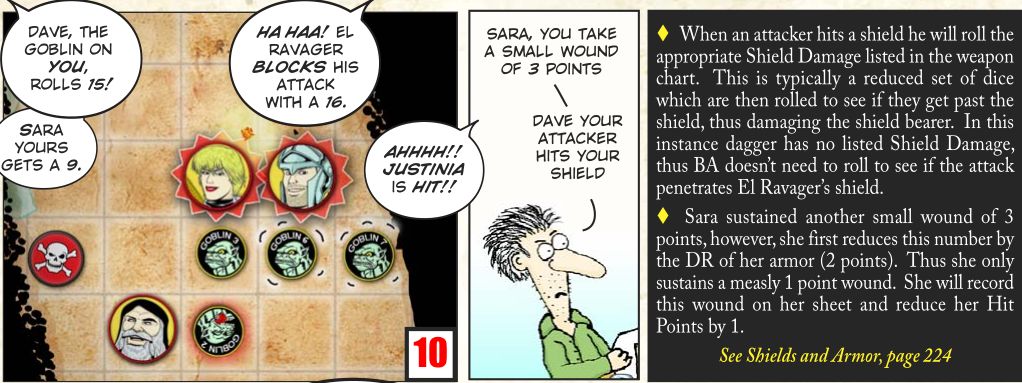
Combat
The best thing about HackMaster is its combat. The design team was not afraid to kill some sacred cows and turn up the crunch factor by a few notches for the sake of verisimilitude. The end result is a complex and deep combat system that might be intimidating at first, but runs really smooth if the GM has their shit together, and the core rules are surprisingly easy to master—mostly because they make sense!
There are no rounds and turns in HackMaster, only counts17. When the battle begins, everyone rolls initiative to see on which count they can act. After they acted, it depends on the action on which count they can act again. Movement can be done on any count, though it might delay, interrupt, or penalize ongoing actions. The first attack is done when you engage your foe; subsequent attacks depend on weapon speed. Similarly, when a spell is finished depends on when you started casting and what the spell’s casting time is. It requires some bookkeeping, but it’s always clear who acts when. Slow-witted allies can be alerted verbally and physically to bring them up on the initiative ladder.
HackMaster threw away good old static Armor Class in favour of separate Defense and Damage Reduction values. Shields, high Wisdom, high Dexterity, and weapon proficiency increase Defense. Armor reduces Defense and hinders movement, but increases DR. The attacker rolls d20p and adds their Attack bonus. The defender rolls d20p18 and adds their Defense bonus. Whoever rolls highest wins the contest—ties go to the defender. Just as attack rolls have automatic hits and potentially criticals on a natural 20, so do defenders achieve Near-Perfect Defense on a natural 19 (a free unarmed attack) and Perfect Defense on a natural 20 (a free riposte).
To keep up with HackMaster’s increased HP, damage dice are typically twice that of D&D’s, and also penetrate. Besides losing hit points and suffering crippling injuries on the epic d10,000 critical tables, damage can also cause Knockback and Trauma. Knockback depends on the target’s size and sends the defender reeling back, potentially also knocking them down in the process. Trauma is based on the Threshold of Pain value of a creature, which is usually around a third of their max HP. When you ToP someone, they fall on the ground and are incapacitated by pain. That’s the perfect opportunity for a coup de grace.
As I already mentioned, shields increase Defense—by a lot! On a shield hit, the attacker still rolls damage though, then reduces it by the shield’s DR. While shield DR is generally good, a particularly nasty blow19 can not only cause damage, but might also break the shield! Against hard-hitting monsters like giants, it’s generally a good idea to put the shield away and focus on dodging instead, because blocking a tree trunk swung towards your face can teach you to fly, knock you out, and break your shield, all at once!
Weapon length also matters. When engaging in melee, whoever has the longest weapon strikes first, while the one with the shorter poker returns the favour the following second. Having a longer weapon can also be used to hold an opponent at bay till they manage to knock the impeding weapon out of their way.
I think that’s enough as an overview for combat. Both HMB and PH have cool KoDT strips that explains combat basics in great detail, though the one in the PHB needs some errata if my memory serves me right. The PH and the GMG also offer a good deal of advanced rules for those who want to count embedded arrows, calculate the momentum of charging opponents, or grapple with the most convoluted grappling rules ever20.
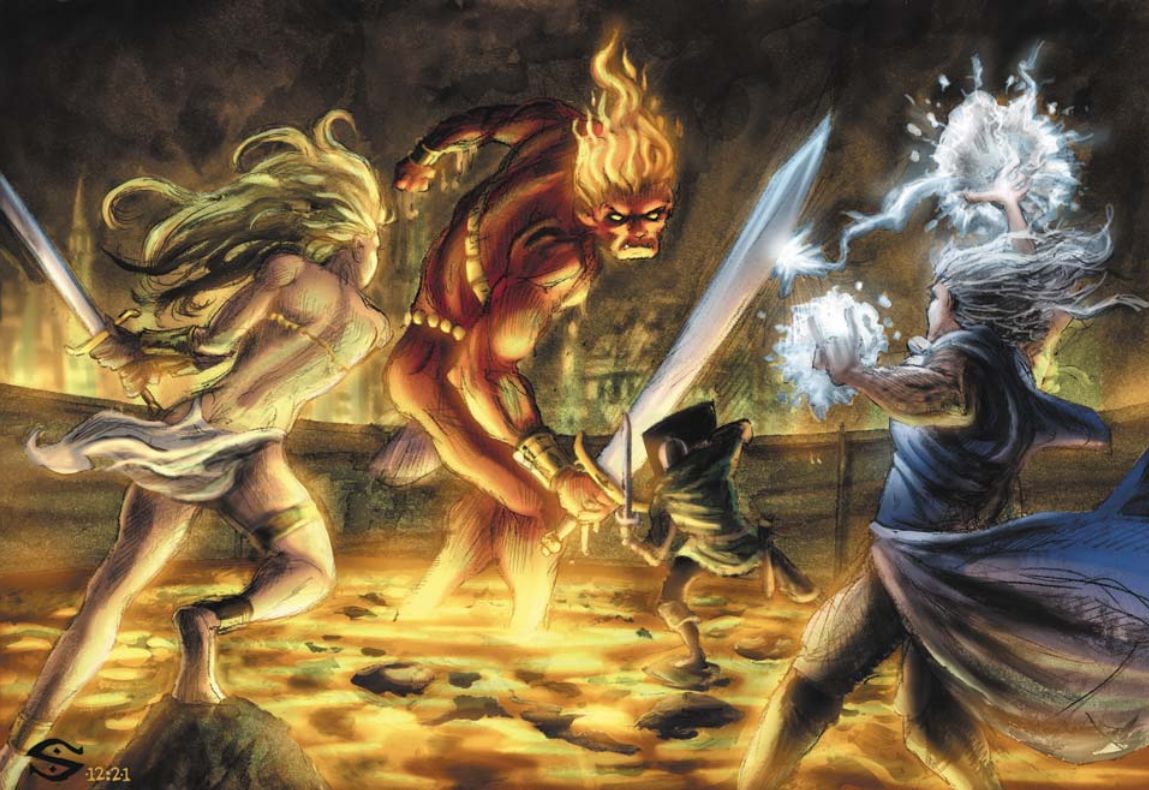
Magic
Clerical magic is pretty close to its roots: clerics prepare spells and lose them on casting. Gods usually don’t allow you to memorize the same spell twice. Mages are a bit more interesting. They use spell points to cast and amplify spells. Each mage spell has info about what you can achieve by burning additional SP on it. Mages also memorize spells, but they don’t forget them after casting. Furthermore, they can cast non-memorized spells from their grimoires, but they cost twice as much as memorized. Rogues also pick up some mage spells during their adventures, but they work slightly differently.
Mages can also suffer spell mishaps! The GMG devotes an entire chapter to the subsystem. If your mage lives a sheltered life and uses magic with care, they will likely forget about the existence of this section. If your mage over-amplifies spells, takes damage while casting, or tries to wear armour21, then get ready for calculating spell volatility and rolling for spell failure! Low-tier mishaps are mostly cosmetic or temporary minor inconveniences, but on higher tiers, things will get ugly with mishaps potentially making the caster return to monke or summoning a black hole that sucks in everything within 10’. Rogues can also screw up spellcasting, but being untrained casters they suffer additional physical damage, some mental handicap, and probably some mishap too. Fortunately they can’t learn high level spells, so they are more dangerous to themselves than their environment.
Game Mastering
Hacklopedia contains a variety of monsters for all levels. Since level 20 in HackMaster is the equivalent of level 10 in AD&D, this means typical high-level threats, like demons, devils22, angels, liches, and dragons23 are missing. On the other hand, the book has its own twists on some creatures and introduces some Tellene-specific ones. We get basilisks that turn people to salt, the 9-foot-tall roving barbarian ogre/orc/elf hybrid grevan, the extremely aggressive sturm wolves, and the great horned owlbeasts if you really want to tear player characters a new one. Alas, there are no guidelines for creating new monsters, but at least there is an appendix about creating humanoid NPCs and pre-made stats for their leaders.
Monsters aren’t the only thing a GM needs, though. That’s where the GMG comes in, which due to its hodgepodge nature ends up being a mixed bag. The GMG expands the already crunchy rules seen in the PH with further mechanics for edge cases, explanations of hazier parts, and provides new subsystems galore. There is a great deal about handling the various types of NPCs, with rules for acquisition, loyalty, morale, and disgruntled NPC activities. Heck, there is a 12-page appendix about different NPC occupations, their roles, their skills, and their prices, from able seamen, through latrine jockeys, to prostitutes!
There are treasures and treasure tables for all levels too in the GMG. The book devotes a surprisingly hefty chunk to mundane treasure, so you can spice up your hoards of silver with decorated weapons, objets d’art, drinking vessels, toys and games, et cetera. The focus on them is no accident. Kingdoms of Kalamar is not a high magic setting, which shows in the section about quality and magic items and the treasure tables too. Magic items are rare, and most of them are consumables. There are +1 to +4 items on the treasure table, but these are just high quality versions of mundane equipment—real magic weapons, shields, and armor start at +5. Magical jewelry and miscellaneous magic items are even rarer. Thus, every magic item is a big deal and worth so much, that there is no real market for them. Hiring a bunch of thugs to recover a magic item is much cheaper than trying to pay its actual value.
The GMG also provides sound guidelines for designing encounters, traps, scenarios, and campaigns. I used them with great success to convert Quest for the Unknown24. Unfortunately, things get sketchy beyond scenarios. There is nothing about strongholds, settlements, regions; even random encounters only get a half-assed mention. I understand that the game is written with a particular setting in mind, but even with all the supplements and atlases, Kalamar is far from as fleshed out as Hârn, and half the fun of GMG-ing is developing your own content for the game, at least for me.
Running HackMaster needs significantly more focus and bookkeeping on the GM’s part than any edition of D&D. Crucial information being split between the PH and GMG doesn’t help with that. Kenzer & Co. and the fandom provided plenty of handouts, ref sheets, tools, and apps to make one’s life easier, and one shouldn’t shy away from using them. The learning curve is steep, but well worth the effort. After the first few sessions, running HackMaster felt like second nature to me.
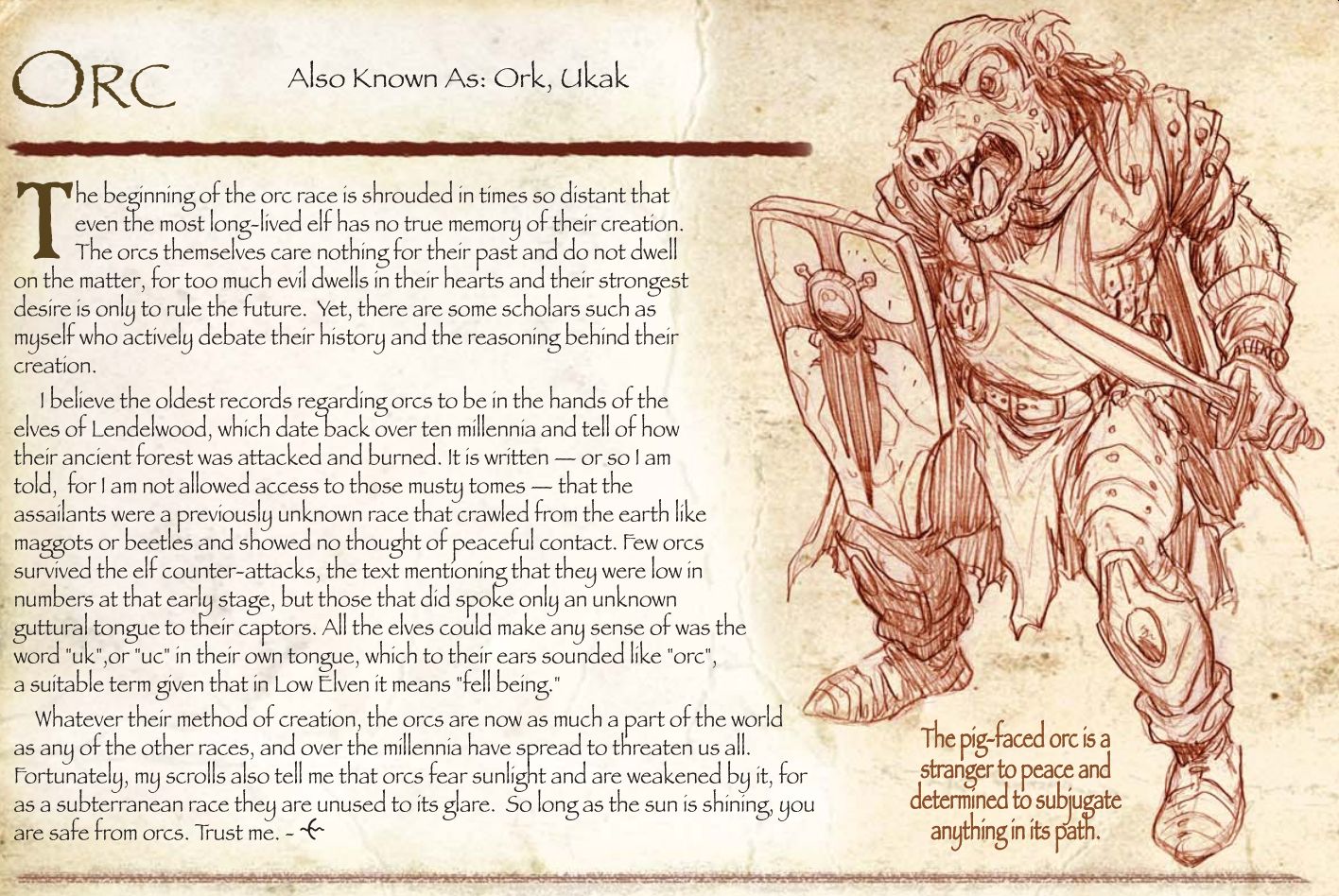
Support
HackMaster’s initial support was pretty good: there were some adventures, including the awesome Frandor’s Keep, and there was a good deal of suuplementary material in HackJournal and Knights of the Dinner Table. The various Zealot’s Guides provided more options for clerics, while the Spellslinger’s Guide began providing some cool options for mages. Regional supplements began to introduce P’Bapar, Shadesh, and Jorikk.
Alas, publishing came to a grinding halt with Steven Johannson’s early passing. Mines of Chaos, the follow-up to Frandor’s Keep, was lost; several projects are still unfinished; the forums were scrapped. The latter was a gut-punch to me because the HackMaster community was one of the friendliest bunches I’ve ever met. The Facebook and Discord groups are still alive and well, but I still feel the with the forums some of community’s heart and soul was lost.
Knights of the Dinner Table still supports HackMaster in every issue with an NPC, magic item, or some other article. There have been plans for storming Kickstarter with a revised edition, but don’t hold your breath—it’s been promised to be “next year” for years now.
Summa Summarum
No matter its flaws, HackMaster is still a fucking a masterpiece. A lot of care, effort, and experience went into designing a game that continues AD&D’s heritage while also revolutionizing its mechanics. This is how AD&D should look in present days, with a huge emphasis on the “Advanced” part. It’s not a game for the faint of heart, for it is crunchy as fuck and asks you to let go of inferior mechanisms and bad habits you picked up during your time spent with other games. It’s well worth the effort to master HackMaster though, for it’s a deep and wide game with one of the most satisfying combat systems ever. I’ve been playing and running games for 26 years by now, and some of my best memories are related to the two HM campaigns I ran. I hope one day Kenzer & Co. get their mojo back and bring forth a glorious revival for the game. And I hope when this day comes, they will include stats for more polearms, because 19 isn’t enough for jackshit.
Rating:
The books are available at the Kenzer & Co. website and on DriveThruRPG.
Disclaimer: The DriveThruRPG links on this site are affiliate links. If you buy something through the link, we’ll get some credit for your purchase too.
-
He already proved that when Kenzer & Co. published their Kingdoms of Kalamar setting for AD&D without a license in the nineties. TSR didn’t want to touch them with a ten-foot pole. ↩
-
The numbering followed the comic books. The first three editions don’t exist in print. Don’t look for them on eBay. ↩
-
HackMaster players were butchering monsters for food, medicine, and components before Dungeon Meshi was a thing. ↩
-
The continent of the Kingdoms of Kalamar setting. ↩
-
HackMaster does bears justice. One of my campaigns ended with a TPK, where the last survivor of a failed dungeon run was mauled to pulp by an agitated grizzly while fleeing. Good times! ↩
-
Militaristic gnomes with an extremely humiliating groin stomp combat technique. ↩
-
Mongrel wood elf guerillas who mingled with humanoids to avoid dying out. ↩
-
Hobgoblins have a significant presence on Tellene and are pretty cool. ↩
-
For hardcore players only. ↩
-
Starting characters cannot start as knights. They have to be a lawful fighter of at least 6th level and must fulfill strict requirements to be knighted. ↩
-
Starting characters cannot start as paladins either. They have to be a lawful good knight of at least 11th level and must fulfill even stricter requirements to earn this rank. ↩
-
Rogues ≠ thieves. They are the social scoundrels, or as David Kenzer put it, “non-wussified bards.” ↩
-
Their looks and charisma penalty can already lead to crippled honor and social skills, so the reaction penalty is really just the icing on the cake. ↩
-
The -1 is there so there is no number left out. Way too many exploding dice systems forget about this and result in skipped numbers. Shame on them. ↩
-
Roleplaying your quirks and flaws properly helps with gaining Honor, which will be explained soon. ↩
-
There are rules for starting at level 0 in the GMG. This is more akin to AD&D’s boring level 0 rules than D3CC RPG’s radical character funnel. ↩
-
Which roughly equals a second. ↩
-
Or lower. When overwhelmed or flanked, this die can drop down as low as a d8p. ↩
-
Emphasis on blows. Puncturing weapons are mostly useless on shield hit. On the other hand, there are weapons that are especially good at breaking through shields and armour. ↩
-
I always tell my players that they are free to use any of the grappling techniques if they learn the rules. That’s the best way of keeping grappling out of your game. ↩
-
True to tradition, elven fighter/mages have an easier time when casting in armour. ↩
-
There are imps, quasits, hellhounds, and a creature called devil, who is right out of folklore. ↩
-
There are drakes, wyrms, lindwyrms, tetzylwyrms. Hacklopedia of Beasts II has a single, very long dragon entry, where it turns out that dragons are male drakes who go into torpor after eating a virgin to grow wings. They are forces of nature. ↩
-
Which was more like redesigning every room and encounter from scratch. ↩
